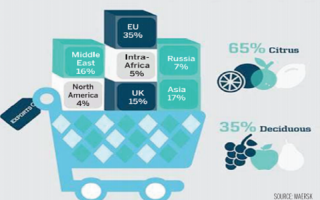From South African Total exports via reefer, to UK 15%, to Russia 7%
for bloggers and agents
Via our unique trade system, and language business, you can choose your African niches to manage them virtually, and make money together with us
For example, Russia – South Africa Reefer shipping business
Become our African agent or blogger.
contacts us here info@sylodium.com
For companies and institutions
Our business language allow users segment their target markets and multiplicate exponentially their possibilites to be found in the Web.
The same but beyond virtual world, in real world, for Premium Users.
Sooner you join us, later you lose the world future web opportunities to dominate your global niche.
This new is from Fresh Plaza
Refrigerated containers made up 19% of SA exports in 2016
The reefer trade (refrigerated cargo solutions) sector contributes positively to the South African economy by creating employment and stimulating economic growth, according to Matthew Conroy, Trade Manager of Maersk Line Southern Africa, a member of Maersk Group
He says that even though 2016 saw the South African reefer market contract by about 3%, largely due to lower crop yields of citrus caused by the severe drought experienced across the region – refrigerated container trade still makes up about 19% of the total South African container exports. “The large majority of produce that gets exported via reefer containers from South Africa is fruit, consisting mainly of citrus and deciduous varieties.

Citrus fruits such as lemons and oranges make up the bulk of this trade, accounting for about 58%, while deciduous fruits such as apples, pears and grapes make up around 35%." Conroy says that in terms of demand, the European continent receives close to 60% of South Africa’s reefer exports, a market which has been very consistent over time. “Our biggest importer region would be the EU, which receives around 35%, while the UK and Russia receive roughly 15% and 7% respectively.
Other import regions include Asia (17%), the Middle East (16%), Intra-Africa (5%) and North America (4%). The market has experienced no major shifts in demand with this split having been largely the same over the past five years.”
source: biznisafrica.co.za

